The NVIDIA SHIELD Android TV Review: A Premium 4K Set Top Box
by Ganesh T S on May 28, 2015 3:00 PM EST- Posted in
- Media Streamer
- Home Theater
- TV
- 4K
- Shield
- NVIDIA
System Performance
From an editorial perspective, the SHIELD Android TV may be one of the most frustrating devices we’ve worked on in recent history. Simply put, the Android TV market is still a tiny market. Google’s Nexus Player is most of the market right now, and only very recently have other Android TV devices such as the Forge TV and SHIELD Android TV reached the market.
As a result, figuring out what to compare the SHIELD Android TV to and how to present it has been an interesting challenge. A set top box is not a mobile device, and while they share similar OSes and the same families of SoCs, that does not make them identical devices. At the same time however, if we restrict ourselves to just Android TV devices, it would be a very limited and uninteresting comparison. The Nexus Player is a quad-core Intel Atom, but only includes 1GB of RAM, among other limitations.
Ultimately it’s clear that the SHIELD Android TV is heavily overspeced compared to other Android TV devices – no one else is pursuing this premium market – so instead we’re going to focus on looking at benchmarked performance relative to the newest generation of SoCs in the latest iOS and Android tablets. This is by no means a fair matchup and we need to be clear about this – the SHIELD Android TV has no throttling or power constraints, no need to balance out energy efficiency – but it at least gives us some idea of how the device and Tegra X1 compare to other products. Just don’t expect to see a Tegra X1 tablet perform this well. And in the meantime, some of the results may surprise you.
As always for an Android device review, we'll start off with our browser benchmarks. SHIELD Android TV doesn’t actually ship with a browser – we had to sideload Chrome – but these are among our most flexible benchmarks and help put performance in context of more than just Android devices.
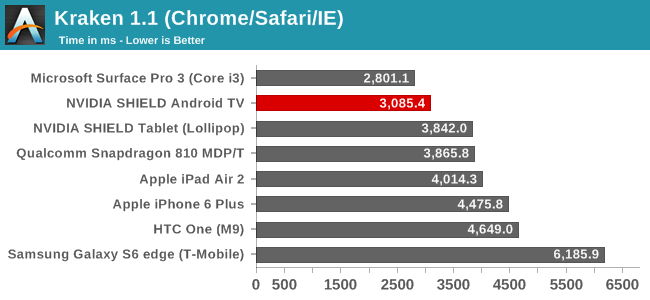
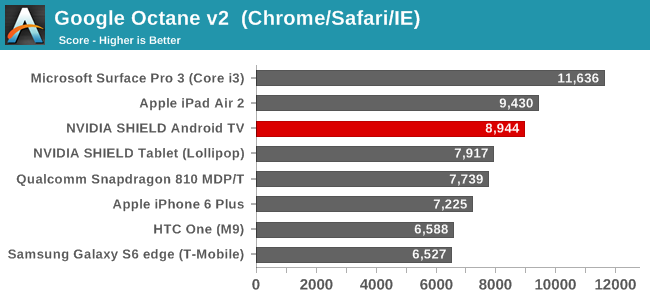
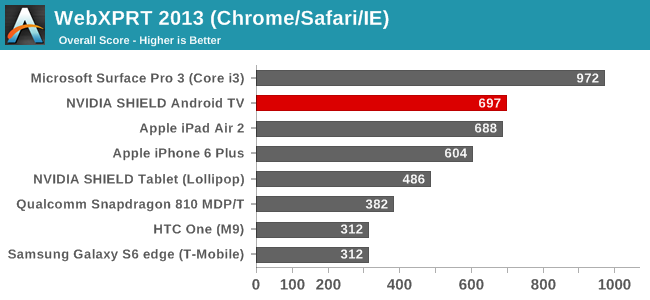
Among Android devices, the SHIELD Android TV stands alone, as you’d expect. Without any throttling to hold it back, it leads over Tegra K1, Snapdragon S810, and Exynos 7420 over all 3 web benchmarks. That said, even with its unrestricted Cortex-A57 CPU cores, we also find that Apple’s A8X-based iPad Air 2 is a close match in Octane and WebXPRT, just edging out the SHIELD Android TV and being edged out respectively. Meanwhile for anyone curious how this compares to high-end x86 tablets like the Surface Pro 3, well even SHIELD Android TV isn’t quite up to par with those devices at this time.
Moving on, we have Basemark OS II 2.0, which should give a better picture of CPU performance in addition to overall device performance.
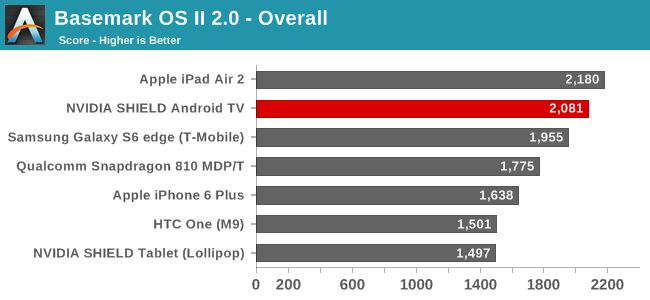

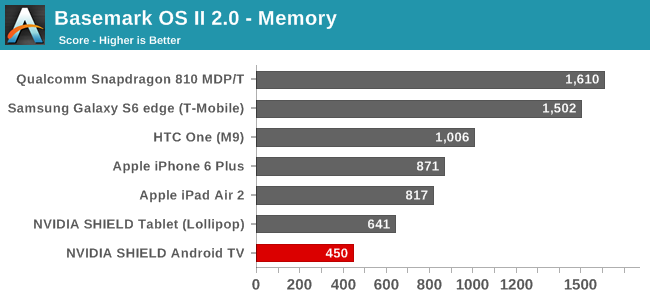
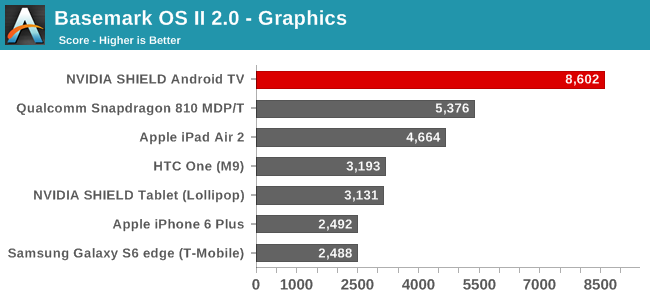
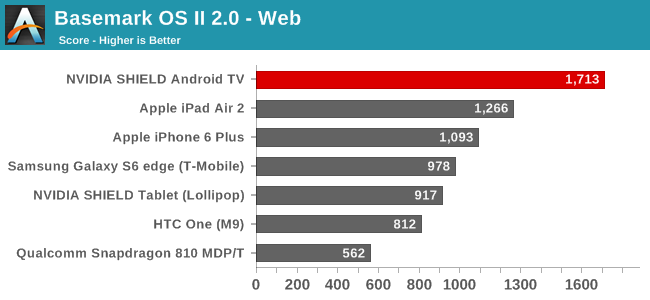
Overall, performance under Basemark still slightly favors the iPad Air 2. SHIELD Android TV easily takes the second spot, but it’s not enough to catch Apple’s tablet.
Looking at the subscores, we can see why this is. SHIELD Android TV only fares decently under the System test, but not well. The big surprise here is not the iPad, which always does well, but the fact that the SHIELD is so far behind the Galaxy S6, which features a similar CPU setup. As this sub-test pushes both the CPU and memory, we may be seeing something related to the implementation differences between Tegra X1 and Exynos 7420, or it may just be an Android TV-inspired difference.
However the memory score is particularly bad, coming in behind even the last-generation SHIELD Tablet. As this is a NAND test, what we're likely seeing is a consequence of the SHIELD's poor random performance, something we'll dive into a bit later in our detailed look at NAND performance.
On the other hand, graphics and web performance are outstanding. We had certainly expected the SHIELD to do well in graphics given what Maxwell is capable of – it is a graphics monster unlike any other current SoC – but the web test is a pleasant surprise. The combination of using Android TV’s built-in web view and the lack of any real throttling likely play a big part here, and although Android TV doesn’t ship with a standard web browser, this bodes well for any apps making use of web view and Javascript.
Our next system benchmark is PCMark, which does a number of basic benchmarks designed to stress various aspects of the device in everyday workloads like video playback, web browsing, text editing, and photo editing. This tends to test every aspect of a mobile device, unlike microbenchmarks that can often miss aspects of the system that can affect performance.
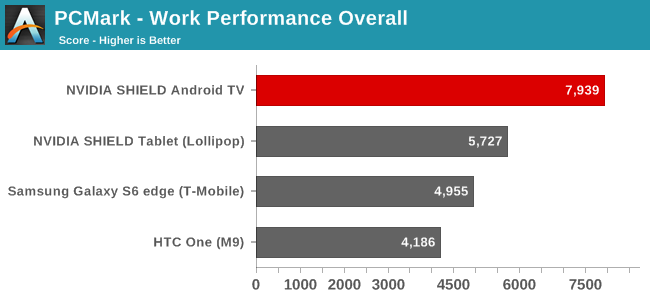
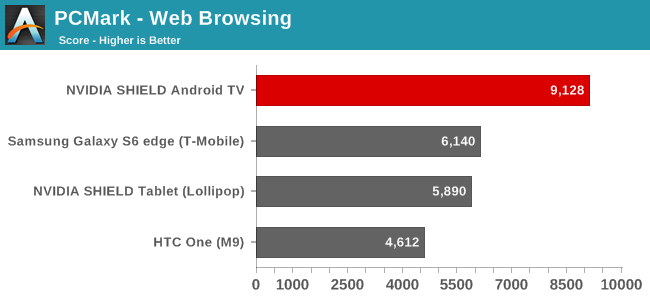

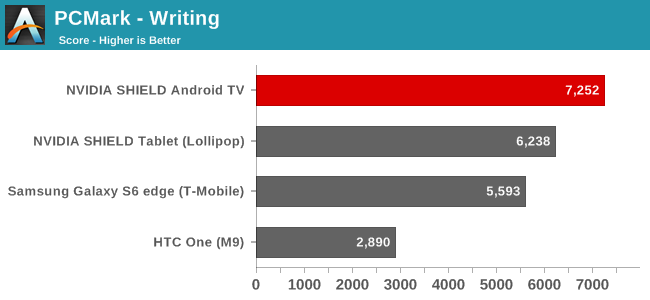
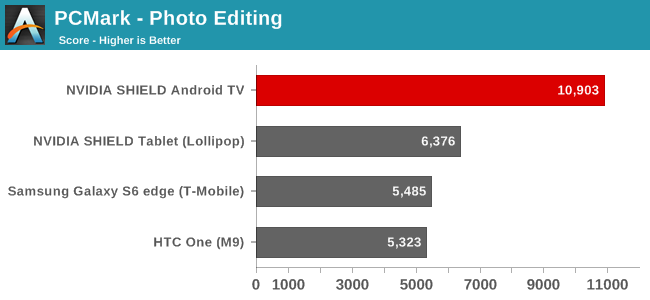
With the exception of the Writing subtest, where the SHIELD Android TV and second-place device are kind of close, PCMark is a runaway victory for the SHIELD Android TV. Once again we’re almost certainly seeing the benefits of the box’s aggressive performance since it doesn’t need to throttle down, or even be conservative on clockspeeds for power purposes. In which case it gives us an interesting look at what Cortex-A57 can do when not held back.
Overall, CPU/system performance is more or less what one would expect based on the design of the SHIELD. As a set top box with a quad-core A57 implementation under the hood and the cooling to let it run wild, SHEILD is frequently A57 at its best. Which means it’s going to easily surpass other A57 devices in most situations, but it also means that even with its unrestricted performance, Apple’s A8X processor and its tri-core “Enhanced Cyclone” CPUs still serve as a reminder of those times where A57 struggles against Enhanced Cyclone’s high-IPC design.
For our final look at system performance, let’s take a quick look at the SHIELD's built-in NAND performance with AndroBench 4.0.
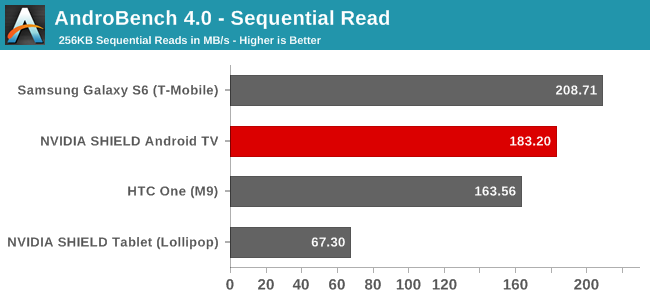
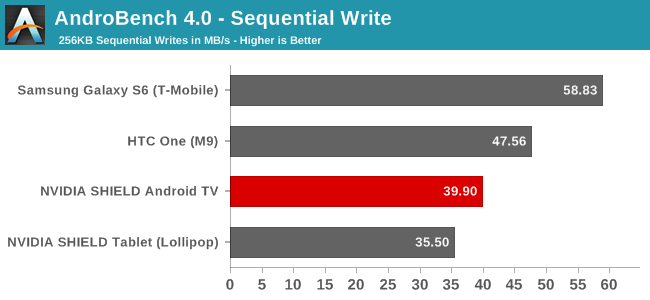
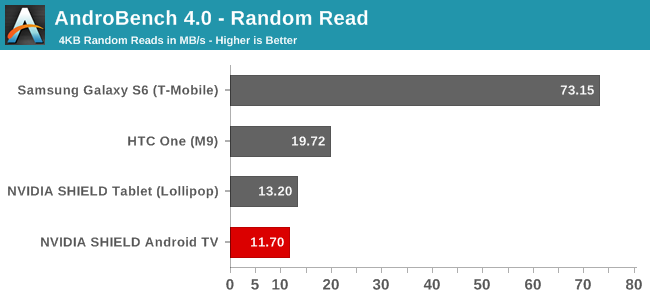
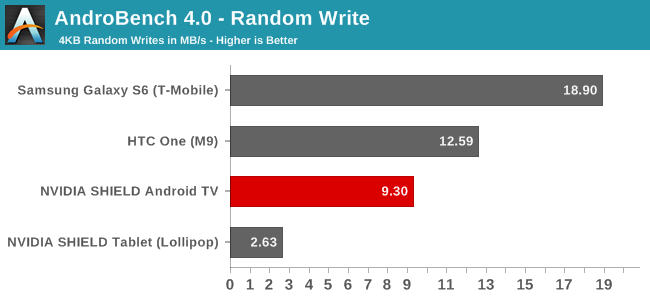
Update 5/28: AndroBench numbers have been revised to account for an error, sorry about that
Though we only have a few AndroBench 4.0 results compiled so far, it’s enough to paint a decent picture. For sequential reads the SHIELD’s built-in NAND fares relatively well. It’s not enough to top the Galaxy S6 and its UFS flash, but it’s keeping up with the pack. Sequential writes on the other hand aren't quite as good, with write performance ahead of only the SHIELD Tablet. Meanwhile random performance is a real mixed bag; the SHIELD Android TV is at the bottom of the random read chart - below even the SHIELD Tablet - while random write performnace is significantly better than the tablet, but still chasing the M9 and well off the S6.
Among Android flagship devices UFS definitely gives the Galaxy a big benefit here, but the SHIELD could stand to improve all the same. However I’m not sure how much that matters to NVIDIA, as the SHIELD is clearly designed to lean on external storage via microSD/USB for users who end up using it for storage-intensive needs such as gaming as opposed to basic set top box streaming.










167 Comments
View All Comments
hero4hire - Monday, June 1, 2015 - link
The question is not a matter of capablability but of utility. A $20-$30 chromecast does most of the functions. A smart TV by itself can do some. The Shield is a luxury device. Using nothing or a Roku on bottom to a ps4 or a htpc on top. Fitting in the middle and attacking a niche is this product.What does the more capable processor provide I've alternatives and am I willing to pay a little more for significantly more capability? That's the value question.
Yojimbo - Thursday, May 28, 2015 - link
"Though it’s a bit of circular logic to say that NVIDIA is intending to exploit these same advantage in the SoC space as they have the desktop space – after all, Maxwell was designed for SoCs first – Maxwell’s capabilities are clearly established at this point."There's a difference between circular logic and redundancy (much like there is a difference between circular logic and a tautology). To say that NVIDIA is intending to exploit the power-efficiency in the SOC space is simply redundant after you already said that NVIDIA designed the architecture that way in the first place. The citing of power efficiency in desktop products is simply giving evidence of power-efficiency. There's no implication of EXTRA power efficiency more than what was originally designed in the architecture by moving from desktop GPUs to the SOC GPUs. How can circular logic appear when no implication is being made?
testbug00 - Thursday, May 28, 2015 - link
"Ultimately it’s clear that the SHIELD Android TV is heavily overspeced compared to other Android TV devices – no one else is pursuing this premium market..."Perhaps because the market isn't large enough to justify a product aimed solely at it? Nvidia can leverage their streaming GPU stuff and a bunch of other stuff no other players really have.
Even with that, I don't think the market is large enough to support one player.
UltraWide - Thursday, May 28, 2015 - link
If I use a receiver and send the audio via bitstream to the receiver, will it play or not? I don't see why bitstreaming of audio requires a license? I thought the license is only required to actually decode the audio on the device and play some downmixed version of it.ganeshts - Thursday, May 28, 2015 - link
Try convincing Dolby, DTS and NVIDIA together :) I am with you on this one, but NVIDIA says licensing is the issue.cfenton - Thursday, May 28, 2015 - link
How does it handle external storage of apps? Android has typically been OK about reading media from an SD card, but it's recently been more and more restrictive about how apps can interact with external storage. Does Android TV (or some Nvidia custom magic) solve that problem? With only 16GB internal (and surely less user accessible) it will quickly run out of room if you want to install games. Recent experience with an Xperia Z3 and Nvidia Shield Tablet have not been promising on this front, at least without root access. The Xperia will copy some data to the external storage device, but still leave some on the internal, and the Shield Tablet is really picky about what games it will transfer to external storage. I'd want to just plug a 2TB portable drive into this thing, have it install everything there, and never think about it again, but based on past experience I'm worried that won't work.I know they want people to use GRID, but until data caps go away that won't be practical in many places.
Ryan Smith - Thursday, May 28, 2015 - link
The SATV can handle apps on SD cards. In fact it has a feature to automatically move newly downloaded apps to the SD card in order to better utilize the space it provides.docbones - Thursday, May 28, 2015 - link
Application support is going to be the biggest item. Will it be updated to run current Amazon Prime, Max Go, HBO Go, CW streaming, etc.Currently none of the Android TV type devices have parity to the number of streaming video apps that my phone does.
chizow - Thursday, May 28, 2015 - link
I didn't have much interest in this product or any of the previous Shield products, but with Windows Media Center's impending doom with Win10 and the prospect of Silicon Dust's HD HomeRun DVR as a viable replacement, I may have to look into getting one.It certainly seems to pack a lot of value and possibilities into a very small price tag of $200. I'm just not sure on the naming/branding, but I guess they think the Android TV aspect may have a higher demand than some of the gaming initiatives they are slowly building upon.
testbug00 - Thursday, May 28, 2015 - link
they really should make a $150 version that is just the console. Probably would increase sales quite a bit... Although, the controller and stuff is probably well under $50 to make however.